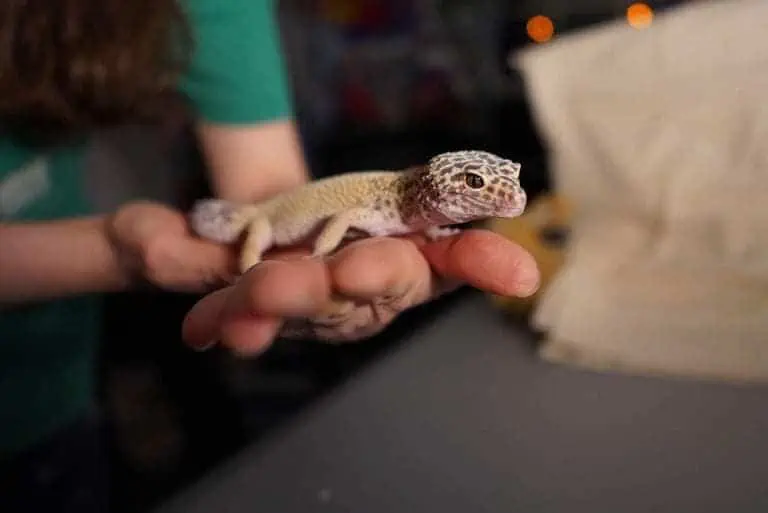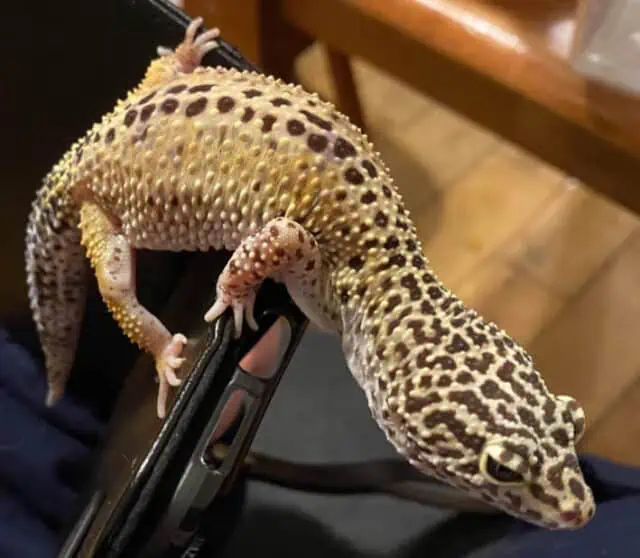Leopard Geckos chirp because they use this unique vocalization to communicate various emotions, conditions, or states of being, ranging from feeling threatened to expressing contentment.
Defensive Behavior: Leopard geckos chirp when feeling threatened, often due to larger animals or improper cohabitation with other geckos.
Handling Matters: Especially in juveniles, incorrect handling can lead to chirping. Remember to let them adjust to their environment and approach them gently.
Enclosure Conditions: Stress due to improper temperature, humidity, or inadequate hiding spots can cause chirping. Ensure a temperature of around 88-92°F (31-33°C) for the warm end and sufficient humidity levels.
Hunger Signs: If your leopard gecko chirps around mealtime, it might be a sign of hunger or excitement at the sight of food.
Happy vs. Stress Chirping: Not all chirps indicate distress! Recognize “happy chirping” which might occur after a successful hunt or when they’re content.
7 Reasons Why Leopard Geckos May Chirp
Leopard Geckos, with their colorful patterns and docile nature, are known for their distinctive chirping sounds, which are not just random noises but are a means to express and communicate. Each chirp, varying in its tone and frequency, relays a specific message or emotion, reflecting the gecko’s internal state or external environment.
They’re Feeling Threatened
Leopard Geckos often rely on their instinctual defensive behavior when they perceive potential dangers, manifesting their discomfort and fear through distinct threat displays and body postures. One prominent aspect of their defense mechanism is chirping. When feeling threatened, they emit these unique sounds as a means to deter predators and communicate their unease.
Leopard Geckos may feel threatened due to various reasons. Encountering larger animals, experiencing uncomfortable cohabitation with other geckos, or facing any form of perceived danger can trigger this response. Their body posture coupled with vocal adaptations like chirping acts as a signal, highlighting their distressed state.
They’re Handled Incorrectly
Incorrect handling is another reason leopard geckos resort to chirping. When they’re not handled with the care and gentleness they require, it induces stress and discomfort, leading them to vocalize their displeasure through chirping. This behavior is especially prevalent in juvenile leopard geckos, who, due to their insecurity and unfamiliarity with their environment, are more susceptible to feeling threatened.
Juvenile geckos are still adapting to their surroundings and developing a sense of security, hence, they are particularly sensitive to how they are handled. Their chirping, in such cases, is a reflection of their unease and a plea for a more cautious approach. It is essential for caretakers to be mindful of this and to allow juvenile geckos ample time to settle into their new homes before initiating the bonding process.
As Mating Calls
Chirping in Leopard Geckos also serves a crucial role in their mating rituals. It acts as a mating call, a form of communication used predominantly by male geckos to attract potential female mates. This specific sound and associated behavior are vital components of their courtship, serving as indicators of interest and availability to the opposite sex.
Male geckos emit unique clicking sounds during courtship to grab the attention of females. The females, in response, exhibit specific behaviors indicating their receptiveness or lack thereof to the advances. The symphony of sounds in leopard gecko courtship is diverse, ranging from distress calls to territorial or mating calls, each conveying different messages and intents.
Because They’re Stressed
Leopard Geckos, like all creatures, experience stress, and chirping is one way they express it. Stress in these reptiles can be attributed to a myriad of factors, each influencing their well-being and behavior significantly. When a leopard gecko feels discomfort, whether due to its environment or interactions, it uses vocal signals like chirping to communicate its distress.
The setup of a leopard gecko’s enclosure, including aspects like temperature, humidity, and the availability of hiding spots, plays a pivotal role in determining their stress levels.
Inadequate or unsuitable conditions within their habitats can lead to heightened stress, causing them to chirp as a manifestation of their discomfort. It is imperative to maintain optimal conditions within their enclosures to ensure their well-being and to prevent stress-induced chirping.
Because of Hunger
Leopard geckos, with their unique behaviors, use chirping as a means to communicate hunger. When they are hungry, they chirp, serving as a vocal signal to express their need for food and their readiness to eat. This hunger-induced chirping is a clear demonstration of their instinctual behaviors around mealtime.
Their chirping can be triggered by various circumstances related to their feeding. For instance, if there’s a delay in their regular feeding schedule or they get overly excited at the sight of food, it can lead to intensified chirping. These triggers signify their eagerness and impatience to receive their meal, highlighting their instinctual drive for sustenance.
Happy Chirping
Leopard geckos are fascinating creatures with a rich palette of vocalizations, one of which is what enthusiasts like to call “Happy Chirping.” This delightful sound is not just a vocal signal but a heartening expression of their contentment and joy. It’s a form of communication that signifies a leopard gecko’s positive emotional state, often reflective of their satisfaction with their environment or even after a successful hunt.
Identifying happy chirping involves observing the circumstances and behaviors accompanying the sound. A content and relaxed posture, coupled with a serene environment, usually characterizes these joyful chirps. These cheerful tones are typically heard when the gecko feels secure and satisfied, possibly due to a well-settled environment or the exhilaration following a fruitful hunt.
Because Of Its Home (Too Small or New Enclosure)
Leopard geckos, like all creatures, require adequate space and a conducive environment to thrive and feel secure. When their home is too cramped, or they are introduced to a new enclosure, it can trigger a response, typically in the form of chirping, indicative of discomfort or stress.
Signs that a gecko’s enclosure is too small or unsuitable may include constant chirping, restlessness, and attempts to escape, highlighting the pressing need for suitable space and habitat conditions.
Providing the right amount of space and a well-structured enclosure is crucial to mitigating stress and preventing the onset of unwanted chirping in leopard geckos. A spacious and properly equipped habitat allows them to exhibit natural behaviors, explore, and find comfortable resting spots, significantly enhancing their overall well-being.
Introducing a leopard gecko to a new environment requires patience and time. Allowing the gecko ample opportunity to explore and acclimate to its new home is essential. Generally, a period of one to two weeks is recommended for adjustment, during which minimal handling and disturbances should be ensured.
During this time, observing the gecko’s behavior and vocalizations can offer insights into its comfort levels and any additional adjustments or modifications required to make the gecko feel at home. A content and acclimated gecko will exhibit less stress-related behaviors, paving the way for a happy and harmonious companionship.
Types of Chirps
Leopard geckos, with their diverse array of vocalizations, express themselves in unique ways. The chirping sounds they make are varied and can signify a range of emotions, needs, or responses to their environment.
Time to Time Chirping
Leopard geckos occasionally engage in what is known as “time to time chirping”, emitting chirps at seemingly random intervals throughout their lives. This type of chirping can perplex even the most seasoned gecko owners, as it may not always have an obvious trigger or clear cause.
However, by closely monitoring alterations in eating habits, activity levels, body posture, and overall behavior, one can start to piece together the potential reasons behind these sporadic vocalizations.
Defensive Mechanism Chirps
Leopard geckos have developed a variety of vocalizations, known as defensive mechanism chirps, as a means to ward off predators and convey aggression. These sounds can range from sharp squeaks and clicking noises to more guttural sounds and even screams, each carrying its own specific meaning.
For instance, when engaged in territorial disputes or fights, geckos may employ distinct chirps to communicate dominance or submission, whereas being caught or feeling threatened might elicit other specific sounds, such as barking.
Juvenile Leopard Geckos Chirping
Juvenile leopard geckos also exhibit chirping behavior, with distinct reasons and expressions compared to their adult counterparts. Young geckos may chirp due to a variety of factors including fear, stress, hunger, and excitement. Their chirping can signify their discomfort, need for food, or even just their energetic disposition.







